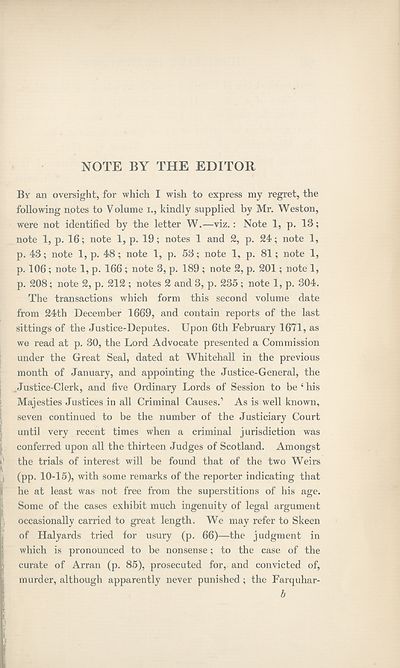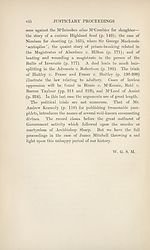Series 1 > Records of the Proceedings of the Justiciary Court Edinburgh, 1661-1678 > Volume 2, 1669-1678
(14) Note by the Editor
Download files
Complete book:
Individual page:
Thumbnail gallery: Grid view | List view

NOTE BY THE EDITOR
By an oversight, for which I wish to express my regret, the
following notes to Volume i., kindly supplied by Mr. Weston,
were not identified by the letter W.—viz. : Note 1, p. 13;
note 1, p. 16; note 1, p. 19; notes 1 and 2, p. 24; note 1,
p. 43; note 1, p. 48; note 1, p. 53; note 1, p. 81; note 1,
p. 106; note 1, p. 166 ; note 3, p. 189 ; note 2, p. 201; note 1,
p. 208; note 2, p. 212 ; notes 2 and 3, p. 235 ; note 1, p. 304.
The transactions which form this second volume date
from 24th December 1669, and contain reports of the last
sittings of the Justice-Deputes. Upon 6th February 1671, as
we read at p. 30, the Lord Advocate presented a Commission
under the Great Seal, dated at Whitehall in the previous
month of January, and appointing the Justice-General, the
.Justice-Clerk, and five Ordinary Lords of Session to be ‘ his
Majesties Justices in all Criminal Causes.1 As is well known,
seven continued to be the number of the Justiciary Court
until very recent times when a criminal jurisdiction was
conferred upon all the thirteen Judges of Scotland. Amongst
the trials of interest will be found that of the two Weirs
(pp. 10-15), with some remarks of the reporter indicating that
he at least was not free from the superstitions of his age.
Some of the cases exhibit much ingenuity of legal argument
occasionally carried to great length. We may refer to Skeen
of Halyards tried for usury (p. 66)—the judgment in
which is pronounced to be nonsense; to the case of the
curate of Arran (p. 85), prosecuted for,, and convicted of,
murder, although apparently never punished; the Farquhar-
b
By an oversight, for which I wish to express my regret, the
following notes to Volume i., kindly supplied by Mr. Weston,
were not identified by the letter W.—viz. : Note 1, p. 13;
note 1, p. 16; note 1, p. 19; notes 1 and 2, p. 24; note 1,
p. 43; note 1, p. 48; note 1, p. 53; note 1, p. 81; note 1,
p. 106; note 1, p. 166 ; note 3, p. 189 ; note 2, p. 201; note 1,
p. 208; note 2, p. 212 ; notes 2 and 3, p. 235 ; note 1, p. 304.
The transactions which form this second volume date
from 24th December 1669, and contain reports of the last
sittings of the Justice-Deputes. Upon 6th February 1671, as
we read at p. 30, the Lord Advocate presented a Commission
under the Great Seal, dated at Whitehall in the previous
month of January, and appointing the Justice-General, the
.Justice-Clerk, and five Ordinary Lords of Session to be ‘ his
Majesties Justices in all Criminal Causes.1 As is well known,
seven continued to be the number of the Justiciary Court
until very recent times when a criminal jurisdiction was
conferred upon all the thirteen Judges of Scotland. Amongst
the trials of interest will be found that of the two Weirs
(pp. 10-15), with some remarks of the reporter indicating that
he at least was not free from the superstitions of his age.
Some of the cases exhibit much ingenuity of legal argument
occasionally carried to great length. We may refer to Skeen
of Halyards tried for usury (p. 66)—the judgment in
which is pronounced to be nonsense; to the case of the
curate of Arran (p. 85), prosecuted for,, and convicted of,
murder, although apparently never punished; the Farquhar-
b
Set display mode to:
![]() Universal Viewer |
Universal Viewer | ![]() Mirador |
Large image | Transcription
Mirador |
Large image | Transcription
Images and transcriptions on this page, including medium image downloads, may be used under the Creative Commons Attribution 4.0 International Licence unless otherwise stated. ![]()
| Scottish History Society volumes > Series 1 > Records of the Proceedings of the Justiciary Court Edinburgh, 1661-1678 > Volume 2, 1669-1678 > (14) Note by the Editor |
|---|
| Permanent URL | https://digital.nls.uk/126926730 |
|---|
| Shelfmark | SCS.SHS.49 |
|---|---|
| Attribution and copyright: |
|
| Attribution and copyright: |
|
|---|
| Description | Over 180 volumes, published by the Scottish History Society, containing original sources on Scotland's history and people. With a wide range of subjects, the books collectively cover all periods from the 12th to 20th centuries, and reflect changing trends in Scottish history. Sources are accompanied by scholarly interpretation, references and bibliographies. Volumes are usually published annually, and more digitised volumes will be added as they become available. |
|---|


